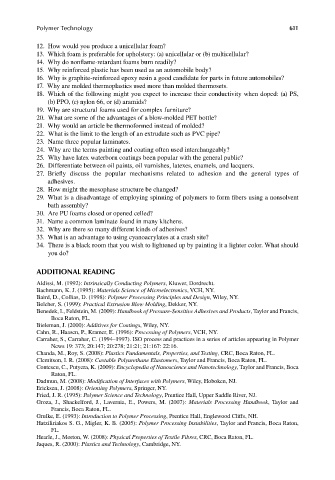Page 648 - Carrahers_Polymer_Chemistry,_Eighth_Edition
P. 648
Polymer Technology 611
12. How would you produce a unicellular foam?
13. Which foam is preferable for upholstery: (a) unicellular or (b) multicellular?
14. Why do nonflame-retardant foams burn readily?
15. Why reinforced plastic has been used as an automobile body?
16. Why is graphite-reinforced epoxy resin a good candidate for parts in future automobiles?
17. Why are molded thermoplastics used more than molded thermosets.
18. Which of the following might you expect to increase their conductivity when doped: (a) PS,
(b) PPO, (c) nylon 66, or (d) aramids?
19. Why are structural foams used for complex furniture?
20. What are some of the advantages of a blow-molded PET bottle?
21. Why would an article be thermoformed instead of molded?
22. What is the limit to the length of an extrudate such as PVC pipe?
23. Name three popular laminates.
24. Why are the terms painting and coating often used interchangeably?
25. Why have latex waterborn coatings been popular with the general public?
26. Differentiate between oil paints, oil varnishes, latexes, enamels, and lacquers.
27. Briefly discuss the popular mechanisms related to adhesion and the general types of
adhesives.
28. How might the mesophase structure be changed?
29. What is a disadvantage of employing spinning of polymers to form fibers using a nonsolvent
bath assembly?
30. Are PU foams closed or opened celled?
31. Name a common laminate found in many kitchens.
32. Why are there so many different kinds of adhesives?
33. What is an advantage to using cyanoacrylates at a crash site?
34. There is a black room that you wish to lightened up by painting it a lighter color. What should
you do?
ADDITIONAL READING
Aldissi, M. (1992): Intrinsically Conducting Polymers, Kluwer, Dordrecht.
Bachmann, K. J. (1995): Materials Science of Microelectronics, VCH, NY.
Baird, D., Collias, D. (1998): Polymer Processing Principles and Design, Wiley, NY.
Belcher, S. (1999): Practical Extrusion Blow Molding, Dekker, NY.
Benedek, I., Feldstein, M. (2009): Handbook of Pressure-Sensitive Adhesives and Products, Taylor and Francis,
Boca Raton, FL.
Bieleman, J. (2000): Additives for Coatings, Wiley, NY.
Cahn, R., Haasen, P., Kramer, E. (1996): Processing of Polymers, VCH, NY.
Carraher, S., Carraher, C. (1994–1997). ISO process and practices in a series of articles appearing in Polymer
News 19: 373; 20:147; 20:278; 21:21; 21:167: 22:16.
Chanda, M., Roy, S. (2008): Plastics Fundamentals, Properties, and Testing, CRC, Boca Raton, FL.
Clemitson, I. R. (2008): Castable Polyurethane Elastomers, Taylor and Francis, Boca Raton, FL.
Contescu, C., Putyera, K. (2009): Encyclopedia of Nanoscience and Nanotechnology, Taylor and Francis, Boca
Raton, FL.
Dadmun, M. (2008): Modifi cation of Interfaces with Polymers, Wiley, Hoboken, NJ.
Ericksen, J. (2008): Orienting Polymers, Springer, NY.
Fried, J. R. (1995): Polymer Science and Technology, Prentice Hall, Upper Saddle River, NJ.
Groza, J., Shackelford, J., Lavernia, E., Powers, M. (2007): Materials Processing Handbook, Taylor and
Francis, Boca Raton, FL.
Grulke, E. (1993): Introduction to Polymer Processing, Prentice Hall, Englewood Cliffs, NH.
Hatziliriakos S. G., Migler, K. B. (2005): Polymer Processing Instabilities, Taylor and Francis, Boca Raton,
FL.
Hearle, J., Morton, W. (2008): Physical Properties of Textile Fibres, CRC, Boca Raton, FL.
Jaques, R. (2000): Plastics and Technology, Cambridge, NY.
9/14/2010 3:43:45 PM
K10478.indb 611 9/14/2010 3:43:45 PM
K10478.indb 611

